Match the following term to its correct description: Lipogenesis.
- The formation of glycogen to store glucose
- The cleavage of glycogen to release glucose
- Triglyceride synthesis
- The start phase of fatty acid breakdown
- The process of forming glucose from noncarbohydrate molecules
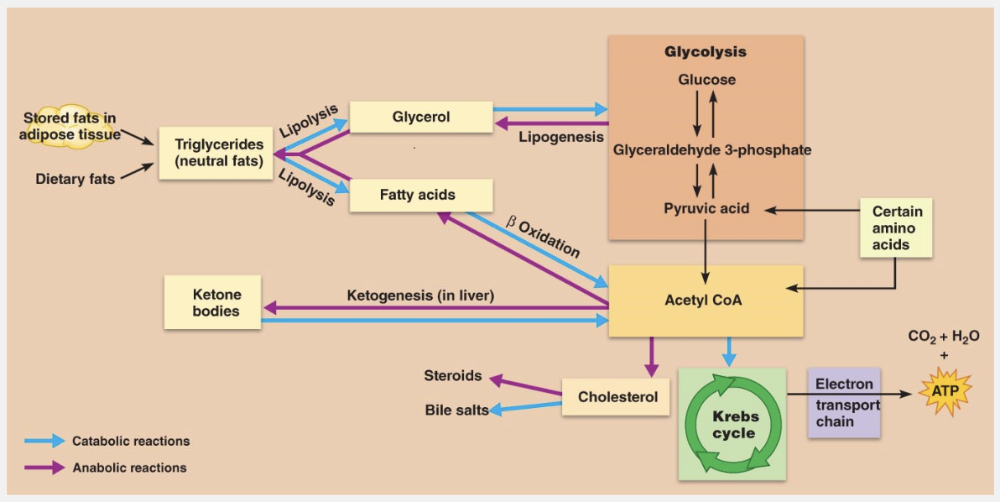
Triglyceride synthesis
Ex.
Lipogenesis involves triglyceride synthesis.
There is a continuous turnover of triglycerides in adipose tissue. New fats are stored for later use, and stored fats are broken down and released to the blood. That bulge of fatty tissue you see today does not contain the same fat molecules it did a month ago.
Glycerol and fatty acids from dietary fats not immediately needed for energy are recombined into triglycerides and stored. About 50% ends up in subcutaneous tissue, and the balance is stockpiled in other fat depots of the body.
Triglyceride synthesis, or lipogenesis, occurs when cellular ATP and glucose levels are high. Excess ATP also leads to an accumulation of acetyl CoA and glyceraldehyde 3-phosphate, two intermediates of glucose metabolism that would otherwise feed into the citric acid cycle. When these two metabolites are present in excess, they are channeled into triglyceride synthesis pathways.
Acetyl CoA molecules are joined together, forming fatty acid chains that grow two carbons at a time. (This accounts for the fact that almost all fatty acids in the body contain an even number of carbon atoms.) Because acetyl CoA, an intermediate in glucose catabolism, is also the starting point for fatty acid synthesis, glucose is easily converted to fat. Glyceraldehyde 3-phosphate is converted to glycerol, which is joined with fatty acids to form triglycerides. Consequently, even with a lowfat diet, carbohydrate intake can provide all the raw materials needed to make triglycerides. When blood sugar is high, lipogenesis is the major activity in adipose tissues and is also an important liver function.
Gluconeogenesis is the process of forming glucose from noncarbohydrate molecules.
Glycogenesis is the formation of glycogen to store glucose.
The cleavage of glycogen to form glucose is called glycogenolysis.
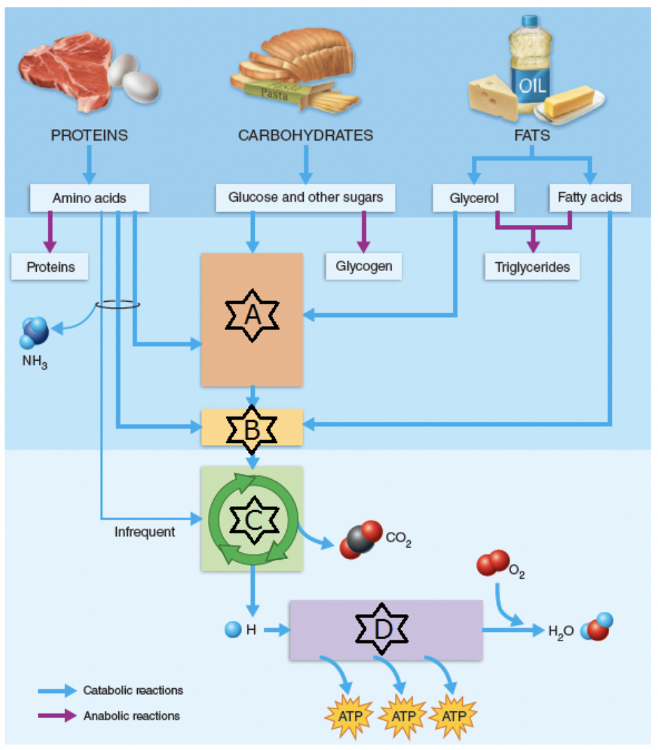
Identify the stage of metabolism at “C”
- Known as the citric acid cycle
- Citric acid cycle
- Occurs in the mitochondria
- Acetyl-CoA is the entry point into the citric acid cycle.
- Also known as the electron transport chain
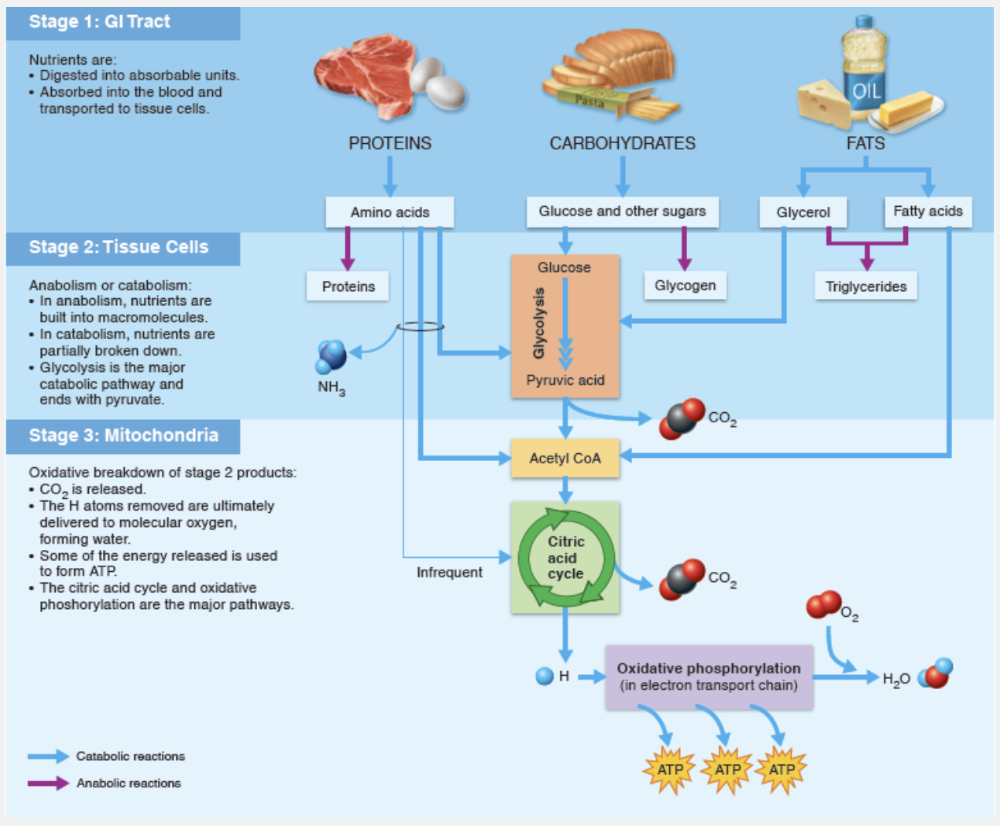
Citric acid cycle
Ex.
The stage of metabolism indicated by letter `C` is citric acid cycle.

The stage of metabolism indicated by “A” occurs in the _________.
- The major catabolic pathway
- Cytoplasm
- Mitochondrial matrix
- Mitochondrial inner membrane
- Mitochondrial outer membrane.

Cytoplasm
Ex.
The stage of metabolism indicated by `A` is glycolysis, which occurs in the cytoplasm.
Cyanide acts as a poison by __________.
- blocking glycolysis
- interfering with the flow of electrons in the electron transport chain
- abolishing the proton gradient by making the cristae membrane permeable to H+
- irreversibly binding to oxygen
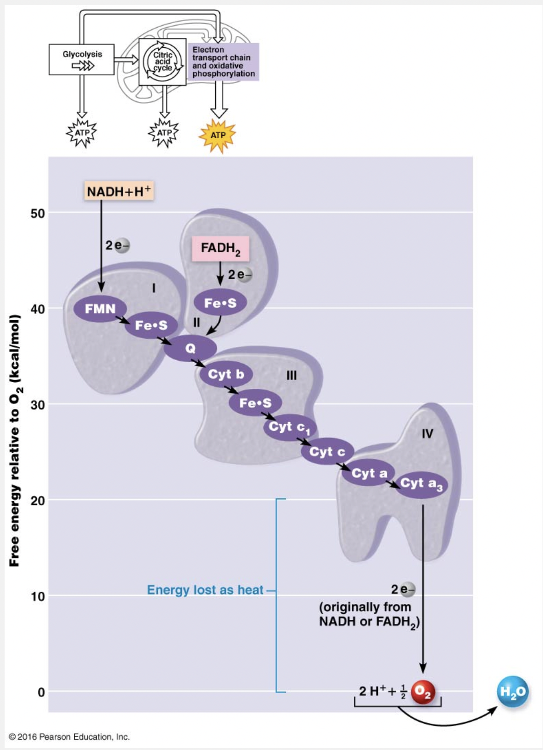
interfering with the flow of electrons in the electron transport chain
Ex.
Cyanide acts as a poison by interfering with the flow of electrons in the electron transport chain.
Studies of metabolic poisons support the chemiosmotic model of oxidative phosphorylation. For example, cyanide (the gas used in gas chambers) disrupts oxidative phosphorylation by binding o cytochrome oxidase and blocking electron flow from complex IV to oxygen. Poisons called “uncouplers” abolish the proton gradient by making the inner mitochondrial membrane permeable to H+. Consequently, although the electron transport chain continues to deliver electrons to oxygen at a furious pace and oxygen consumption rises, no ATP is made.
Match the cellular respiration term with the correct characteristic: Beta oxidation.
- Results in fatty acid chains being broken down
- Initial metabolite is citric acid
- Requires ATP synthase at end
- End product is pyruvic acid
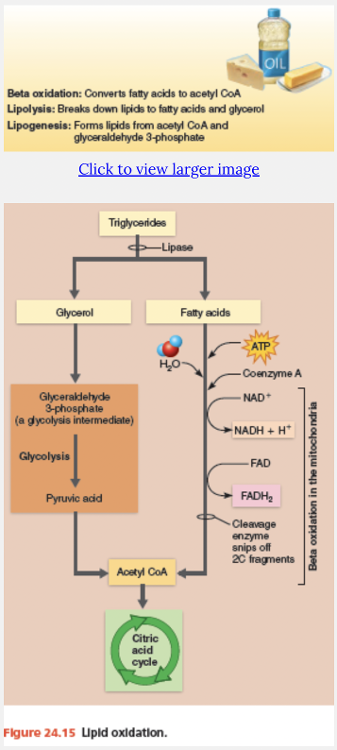
Results in fatty acid chains being broken down
Ex.
Beta oxidation results in fatty acid chains being broken down.
Beta oxidation, the initial phase of fatty acid oxidation, occurs in the mitochondria. The net result is that the fatty acid chains are broken apart into two-carbon acetic acid fragments, and coenzymes (FAD and NAD+) are reduced. Each acetic acid molecule is fused to coenzyme A, forming acetyl CoA. The term “beta oxidation” reflects the fact that the carbon in the beta (third) position is oxidized each time a two-carbon fragment is broken off. Acetyl CoA then enters the citric acid cycle where it is oxidized to CO2 and H2O.
Match the following term to its correct description: Gluconeogenesis.
- The start phase of fatty acid breakdown
- The formation of glycogen to store glucose
- The cleavage of glycogen to release glucose
- The process of forming glucose from noncarbohydrate molecules
- Triglyceride synthesis
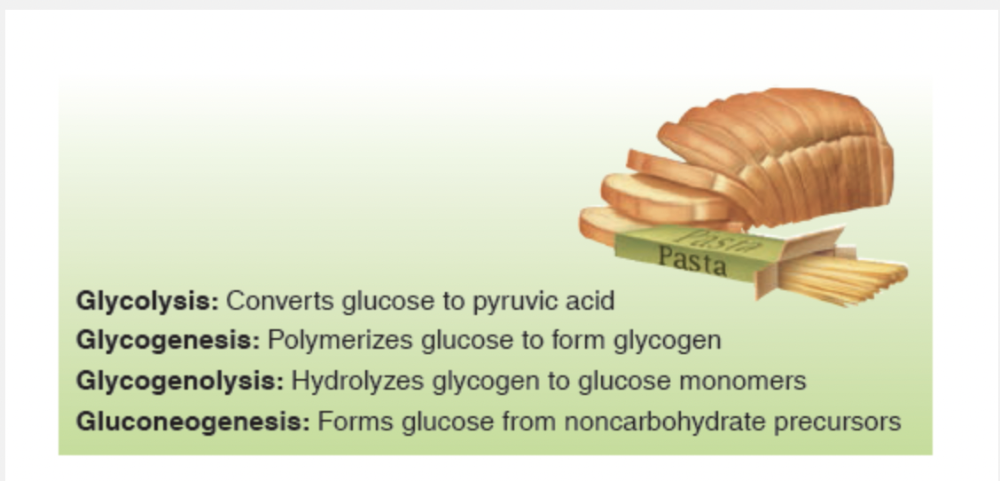
The process of forming glucose from noncarbohydrate molecules
Ex.
Gluconeogenesis is the process of forming glucose from noncarbohydrate molecules.
When too little glucose is available to stoke the “metabolic furnace,” glycerol and amino acids are converted to glucose. Gluconeogenesis, the process of forming new (neo) glucose from noncarbohydrate molecules, occurs in the liver. Gluconeogenesis takes place when dietary sources and glucose reserves have been used up and blood glucose levels are beginning to drop. Gluconeogenesis protects the body, especially the nervous system, from the damaging effects of low blood sugar (hypoglycemia) by ensuring that ATP synthesis can continue.
Glycogenesis is the formation of glycogen to store glucose.
The cleavage of glycogen to form glucose is called glycogenolysis.
Glycogenolysis is the cleavage of glycogen to release glucose.
Triglyceride synthesis is called lipogenesis.

Identify the stage of metabolism at “B”
- Acetyl-CoA is the entry point into the citric acid cycle.
- Also known as the electron transport chain.
- Occurs in the cytoplasm of tissue cells
- The major catabolic pathway
- Acetyl CoA
- Is also known as the citric acid cycle
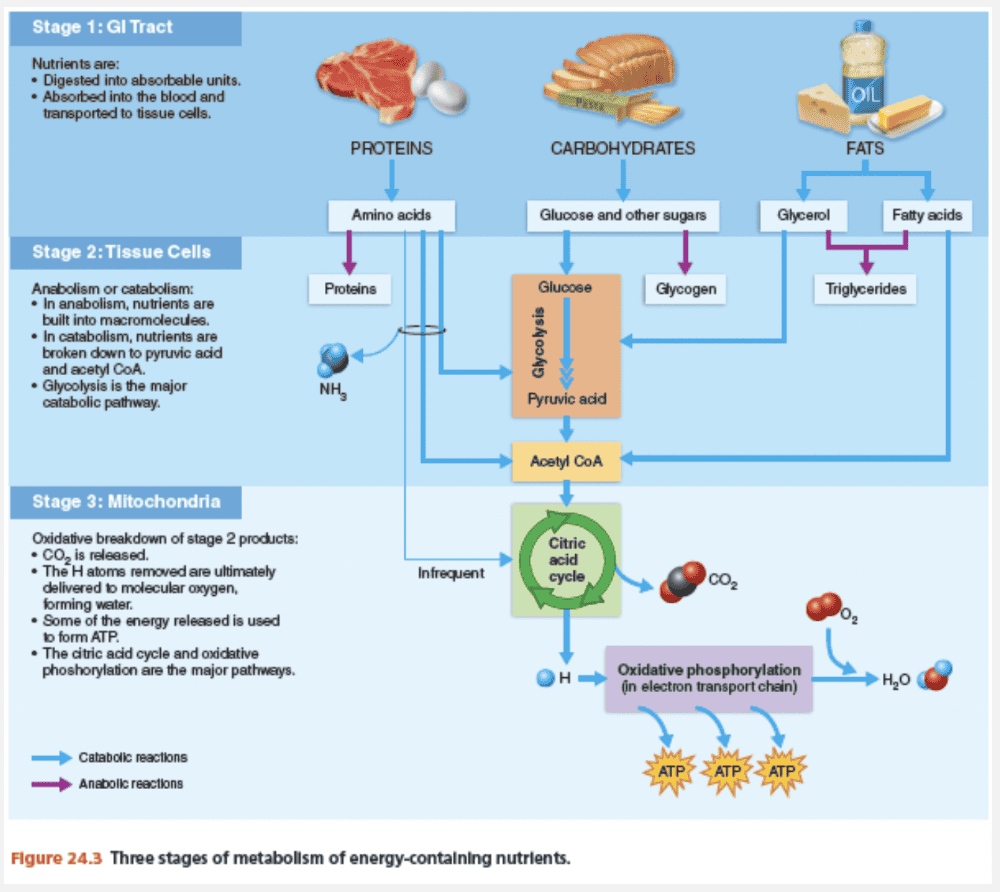
Acetyl CoA
Ex.
The stage of metabolism indicated by letter `B` is Acetyl CoA.
Match the nutrient with its correct set of characteristics: Protein.
- Small organic molecules; important as coenzymes; fat-soluble forms are A, D, E, and K
- Composed of simple sugars; used as the major fuel source for cellular respiration
- Most are electrolytes; some are important as cofactors
- Composed of amino acids; used to build structural components of cells as well as functional components (enzymes)
- Composed of fatty acids and glycerol; should be 20%–35% of caloric intake
Composed of amino acids; used to build structural components of cells as well as functional components (enzymes)
Ex.
Proteins are composed of amino acids, are used to build structural components of cells as well as functional components (enzymes).
Proteins are important structural materials of the body, including, for example, keratin in skin, collagen and elastin in connective tissues, and muscle proteins. In addition, functional proteins such as enzymes and some hormones regulate an incredible variety of body functions. Whether amino acids are used to synthesize new proteins or burned for energy depends on a number of factors.
Carbohydrates are composed of simple sugars and are used as the major fuel source for cellular respiration.
Triglycerides are composed of fatty acids and glycerol and should be 20%–35% of caloric intake.
Minerals act as electrolytes, and some serve as enzyme cofactors.
Vitamins are small organic molecules that are important as coenzymes.
Most of the ATP produced during cellular respiration is produced by __________.
- glycolysis
- substrate-level phosphorylation
- gluconeogenesis
- oxidative phosphorylation during the chemiosmotic process
- the Krebs cycle
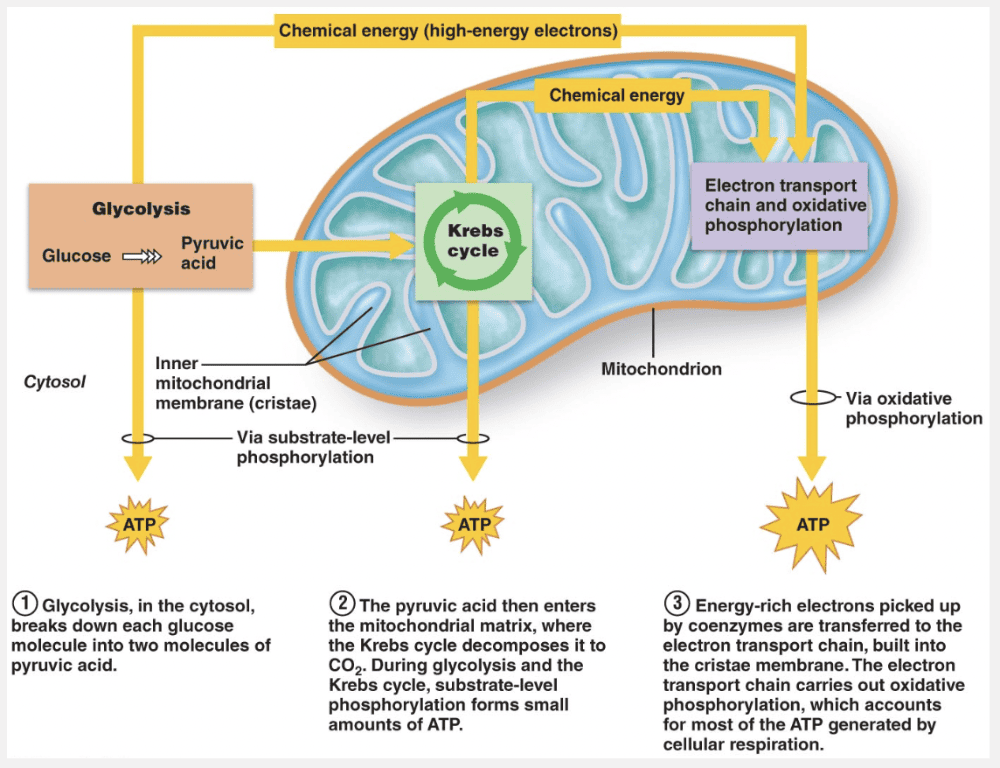
oxidative phosphorylation during the chemiosmotic process
Ex.
Most of the ATP produced during cellular respiration is produced by oxidative phosphorylation during the chemiosmotic process.
How do our cells capture some of the energy liberated during cellular respiration to make ATP molecules? There are two mechanisms: substrate-level phosphorylation and oxidative phosphorylation.
Substrate-level phosphorylation occurs when high-energy phosphate groups are transferred directly from phosphorylated substrates (metabolic intermediates such as glyceraldehyde 3-phosphate) to ADP. Essentially, this process occurs because the high-energy bonds attaching the phosphate groups to the substrates are even more unstable than those in ATP. ATP is synthesized by this route twice during glycolysis, and once during each turn of the citric acid cycle. The enzymes catalyzing substrate-level phosphorylations are located in both the cytosol (where glycolysis occurs) and in the watery matrix inside the mitochondria (where the citric acid cycle takes place). Oxidative phosphorylation is more complicated, but it also releases most of the energy that is eventually captured in ATP bonds during cellular respiration. Oxidative phosphorylation, which is carried out by electron transport proteins embedded in the inner mitochondrial membranes, is an example of a chemiosmotic process. Chemiosmotic processes couple the movement of substances across membranes to chemical reactions.

Identify the stage of metabolism at “D”
- Acetyl-CoA is the entry point into the citric acid cycle.
- Occurs in the cytoplasm of tissue cells
- Also known as the electron transport chain
- The major catabolic pathway
- Oxidative phosphorylation

Oxidative phosphorylation
Ex.
The stage of metabolism indicated by letter `D` is oxidative phosphorylation.
Match the following term to its correct description: Glycogenolysis.
- The formation of glycogen to store glucose
- Triglyceride synthesis
- The start phase of fatty acid breakdown
- The cleavage of glycogen to release glucose
- The process of forming glucose from noncarbohydrate molecules
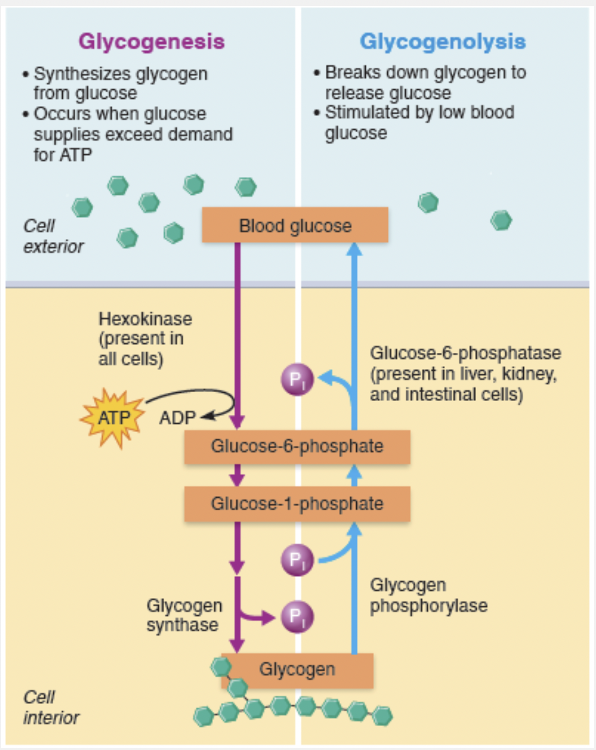
The cleavage of glycogen to release glucose
Ex.
Glycogenolysis is the cleavage of glycogen to release glucose.
When blood glucose levels drop, glycogen lysis (splitting) occurs. This process is known as glycogenolysis (gli″ko-jĕ-nol′ĭ-sis). The enzyme glycogen phosphorylase oversees phosphorylation and splitting of glycogen to release glucose-1-phosphate, which is then converted to glucose-6-phosphate, a form that can enter the glycolysis pathway to be oxidized for energy.
In muscle cells and most other cells, the glucose-6-phosphate resulting from glycogenolysis is trapped because it cannot cross the cell membrane. However, hepatocytes (and some kidney and intestinal cells) contain glucose-6-phosphatase, an enzyme that removes the terminal phosphate, producing free glucose. Because glucose can then readily diffuse from the cell into the blood, the liver can use its glycogen stores to provide blood sugar for other organs when blood glucose levels drop. Liver glycogen is also an important energy source for skeletal muscles that have depleted their own glycogen reserves.
In glycolysis, glucose must be activated with the use of how many ATP molecules?
- Two
- One
- Three
- Five
- Ten
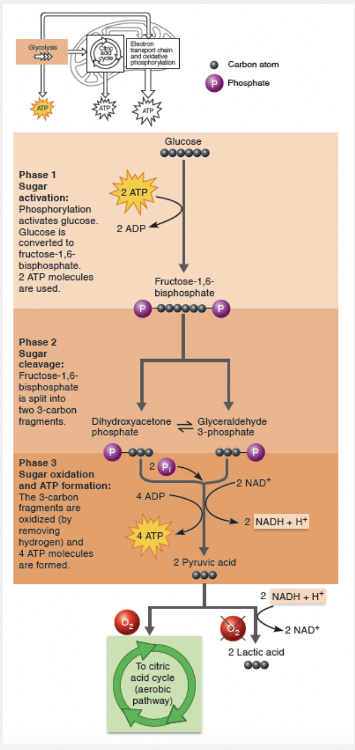
Two
Ex.
In glycolysis, glucose must be activated with the use of two ATP molecules.
In phase 1, glucose is phosphorylated and converted to fructose-6-phosphate, which is then phosphorylated again. These three steps use two ATP molecules (which are recouped later) and yield fructose-1,6-bisphosphate. The two separate reactions of the sugar with ATP provide the activation energy needed to prime the later stages of the pathway, so phase 1 is sometimes called the energy investment phase.
Match the following event of metabolism with the process occurring: Lipolysis.
- Breakdown of glucose
- Production of glucose from a noncarbohydrate sources
- Removal of NH3
- Breakdown of lipids
- Polymerization of glucose
- Triglyceride synthesis
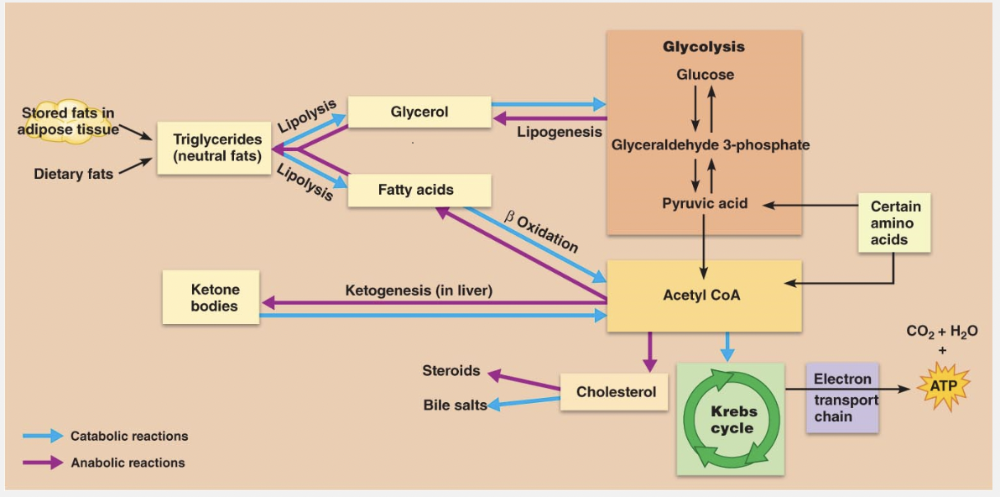
Breakdown of lipids
Ex.
Lipolysis is the breakdown of lipids.
Lipolysis (lĭ-pol′ĭ-sis; “fat splitting”), the breakdown of stored fats into glycerol and fatty acids, is essentially lipogenesis in reverse (Figure 24.16, blue arrows). The fatty acids and glycerol are released to the blood, helping to ensure that body organs have continuous access to fat fuels for aerobic respiration. (The liver, cardiac muscle, and resting skeletal muscles actually prefer fatty acids as an energy fuel.)
The adage “Fats burn in the flame of carbohydrates” becomes clear when carbohydrate intake is inadequate. Under such conditions, lipolysis accelerates as the body attempts to fill the fuel gap with fats. However, the ability of acetyl CoA to enter the citric acid cycle depends on having sufficient carbohydrate intermediate molecules. When carbohydrates are deficient, these intermediates are converted to glucose (to fuel the brain). Without them, fat oxidation is incomplete, and acetyl CoA accumulates.
Via a process called ketogenesis, the liver converts acetyl CoA molecules to ketone bodies, or ketones, which are released into the blood. Ketone bodies include acetoacetic acid, β-hydroxybutyric acid, and acetone. (The keto acids cycling through the citric acid cycle and the ketone bodies resulting from fat metabolism are quite different and should not be confused.)
The breakdown of glucose is called glycolysis.
Gluconeogenesis is the process of forming glucose from noncarbohydrate molecules.
Polymerization of glucose occurs during glycogenesis, the formation of glycogen to store glucose.
Removal of NH3 from amino acids is called deamination.
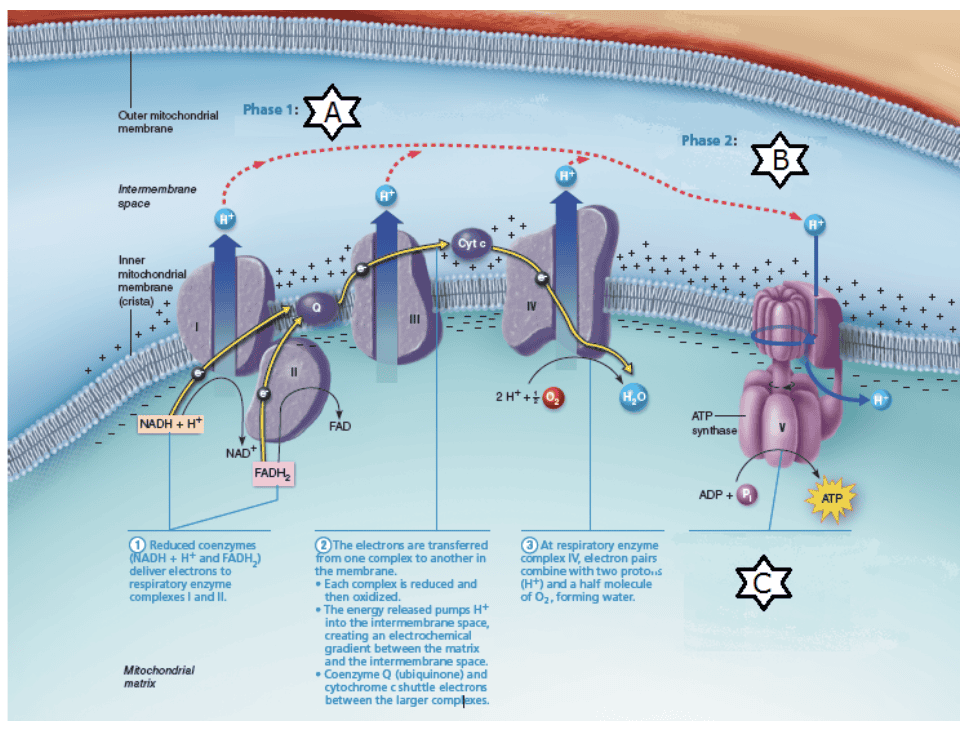
Identify the physiological step at “C.”
- Electron transport creates the proton gradient.
- Chemiosmosis uses the proton gradient to synthesize ATP.
- ATP synthase harnesses the energy of the proton gradient to synthesize ATP.
- Reduction of cytochrome C is occurring.
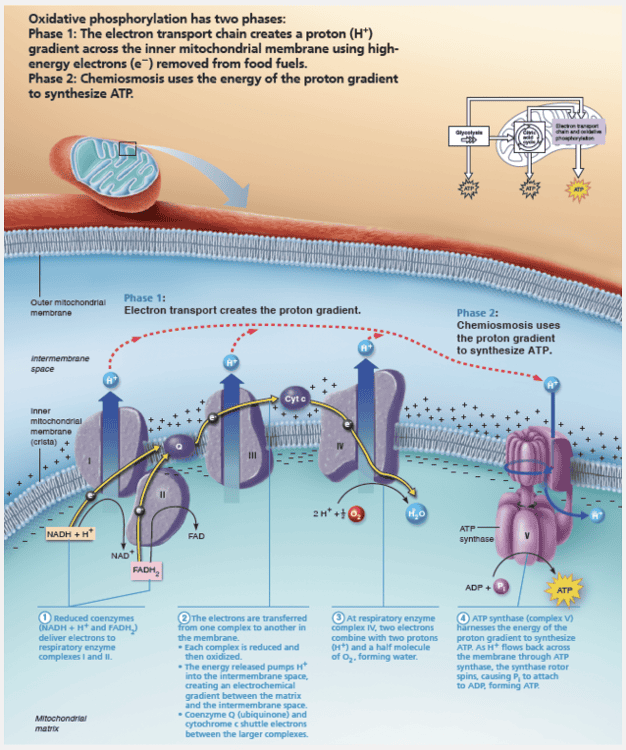
ATP synthase harnesses the energy of the proton gradient to synthesize ATP.
Ex.
As shown in the figure, “C” represents the step where ATP synthase harnesses the energy of the proton gradient to synthesize ATP.
As proteins are broken down for energy, __________ is generated; the liver then converts this potentially toxic intermediate into __________.
- ammonia; urea
- ammonia; glucose
- acid; ammonia
- urea; water
ammonia; urea
Ex.
As proteins are broken down for energy, ammonia is generated; the liver then converts this potentially toxic intermediate into urea.
In the liver, the amine group of glutamic acid is removed as ammonia (NH3), and α-ketoglutaric acid is regenerated. The liberated NH3 molecules are combined with CO2, yielding urea and water. The urea is released to the blood and excreted from the body in urine. Because ammonia is toxic to body cells, the ease with which glutamic acid funnels amine groups into the urea cycle is extremely important. This cycle rids the body not only of NH3 produced during oxidative deamination, but also of blood borne NH3 produced by intestinal bacteria.
Which of the following describes the products of glycolysis?
- Produces five carbon dioxide molecules and ten molecules of reduced coenzymes (NADH + H+ and FADH2)
- Provides the most ATP and 12 H2O molecules
- Produces both NADH + H+ as well as CO2
- Produces two molecules of pyruvic acid, four ATP, and two NADH + H+

Produces two molecules of pyruvic acid, four ATP, and two NADH + H+
Ex.
Glycolysis Produces two molecules of pyruvic acid, four ATP, and two NADH + H+.
The final products of glycolysis are two molecules of pyruvic acid and two molecules of reduced NAD+ (which is NADH + H+). There is a net gain of two ATP molecules per glucose molecule. Four ATPs are produced, but remember that two are consumed in phase 1 to “prime the pump.” Each pyruvic acid molecule has the formula C3H4O3, and glucose is C6H12O6. Between them the two pyruvic acid molecules have lost four hydrogen atoms, whose electrons are now bound to two molecules of NAD+. NAD carries a positive charge (NAD+), so when it accepts a hydrogen pair, NADH + H+ is the resulting reduced product. Although a small amount of ATP has been harvested, the other two products of glucose oxidation (H2O and CO2) have yet to appear.
Which of the following is the correct description of glycogenesis?
- Triglyceride synthesis
- The start phase of fatty acid breakdown
- The formation of glycogen to store glucose
- The process of forming glucose from noncarbohydrate molecules
- The cleavage of glycogen to release glucose

The formation of glycogen to store glucose
Ex.
Glycogenesis is the formation of glycogen to store glucose.
When high ATP levels begin to “turn off” glycolysis, glucose molecules are combined in long chains to form glycogen, the animal carbohydrate storage product. This process is called glycogenesis (glyco = sugar; genesis = origin).
Glycogenesis begins as glucose entering cells is phosphorylated to glucose-6-phosphate and then converted to its isomer, glucose-1-phosphate. The terminal phosphate group is split off as the enzyme glycogen synthase catalyzes the attachment of glucose to the growing glycogen chain. Liver and skeletal muscle cells are most active in glycogen synthesis and storage.
The cleavage of glycogen to form glucose is called glycogenolysis.
Gluconeogenesis is the process of forming glucose from noncarbohydrate molecules.
Glycogenolysis is the cleavage of glycogen to release glucose.

Identify the physiological step at “A.”
- Chemiosmosis uses the proton gradient to synthesize ATP.
- Electron transport creates the proton gradient.
- Reduction of cytochrome C is occurring.
- ATP synthase harnesses the energy of the proton gradient to synthesize ATP.

Electron transport creates the proton gradient.
Ex.
As shown in the figure, “A” represents the step where electron transport creates the proton gradient.
Match the following term to its correct description: Beta oxidation.
- The process of forming glucose from noncarbohydrate molecules
- The formation of glycogen to store glucose
- Triglyceride synthesis
- The start phase of fatty acid breakdown
- The cleavage of glycogen to release glucose

The start phase of fatty acid breakdown
Ex.
Beta oxidation is the starting phase of fatty acid breakdown.
Beta oxidation, the initial phase of fatty acid oxidation, occurs in the mitochondria. The net result is that the fatty acid chains are broken apart into two-carbon acetic acid fragments, and coenzymes (FAD and NAD+) are reduced. Each acetic acid molecule is fused to coenzyme A, forming acetyl CoA. The term “beta oxidation” reflects the fact that the carbon in the beta (third) position is oxidized each time a two-carbon fragment is broken off. Acetyl CoA then enters the citric acid cycle where it is oxidized to CO2 and H2O.
Match the cellular respiration term with the correct characteristic: Oxidative phosphorylation.
- Initial metabolite is citric acid
- Requires ATP synthase at end
- Results in fatty acid chains being broken down
- End product is pyruvic acid

Requires ATP synthase at end
Ex.
Oxidative phosphorylation requires ATP synthase at end.
The only areas of the mitochondrial membrane freely permeable to H+ are large enzyme-protein complexes (complex V) called ATP synthases. These complexes, which populate the inner mitochondrial membrane, lay claim to being nature’s smallest rotary motors. This motor drives a molecular mill that “grinds” ADP and Pi together into ATP. As the protons flow through, they bind to a subunit of the rotor, causing it to change shape and forcing the rotor to spin. The spinning rotor turns a connecting rod within a stationary knob. This mechanical action catalyzes the formation of ATP.
Notice something here: The ATP synthase works like an ion pump running in reverse. Recall from Chapter 3 that ion pumps use ATP as their energy source to transport ions against an electrochemical gradient. Here we have ATP synthases using the energy of a proton gradient to power ATP synthesis.

Identify the stage of metabolism at “A”
- Glycolysis
- Acetyl-CoA is the entry point into the citric acid cycle.
- Occurs in the mitochondria
- Is also known as the citric acid cycle
- Occurs in the cytoplasm of tissue cells
- Also known as the electron transport chain

Glycolysis
Ex.
The stage of metabolism indicated by letter `A` is glycolysis.
Which of the following is a description of lipids?
- Made up of ribose or deoxyribose sugars and nitrogenous bases
- Most is ingested in the form of starch
- Triglycerides are the most common in diet
- Built of long chains of amino acids
Triglycerides are the most common in diet
Ex.
Lipids are the triglycerides that are the most common in diet.
The most abundant dietary lipids are triglycerides (Chapter 2). We eat saturated fats in animal products such as meat and dairy foods, in a few tropical plant products such as coconut, and in hydrogenated oils (trans fats) such as margarine and solid shortenings used in baking. Unsaturated fats are present in seeds, nuts, olive oil, and most vegetable oils.
The final product(s) of glycolysis is (are) __________.
- glyceraldehyde 3-phosphate
- the formation of four ATP molecules
- two molecules of pyruvic acid, two molecules of reduced NAD+, and a net gain of two ATP
- the production of acetyl coenzyme A

two molecules of pyruvic acid, two molecules of reduced NAD+, and a net gain of two ATP
Ex.
The final products of glycolysis are two molecules of pyruvic acid and two molecules of reduced NAD+ (which is NADH + H + ). There is a net gain of two ATP molecules per glucose molecule. Four ATPs are produced, but remember that two are consumed in phase 1 to “prime the pump.” Each pyruvic acid molecule has the formula C3H4O3, and glucose is C6H12O6. Between them the two pyruvic acid molecules have lost four hydrogen atoms, whose electrons are now bound to two molecules of NAD+. NAD carries a positive charge (NAD+), so when it accepts a hydrogen pair, NADH + H+ is the resulting reduced product. Although a small amount of ATP has been harvested, the other two products of glucose oxidation (H2O and CO2) have yet to appear.
Which of the following is the correct description of the Citric acid cycle (or Krebs cycle)?
- End product is pyruvic acid
- Fueled largely by pyruvic acid
- Requires ATP synthase at end
- Results in fatty acid chains being broken down
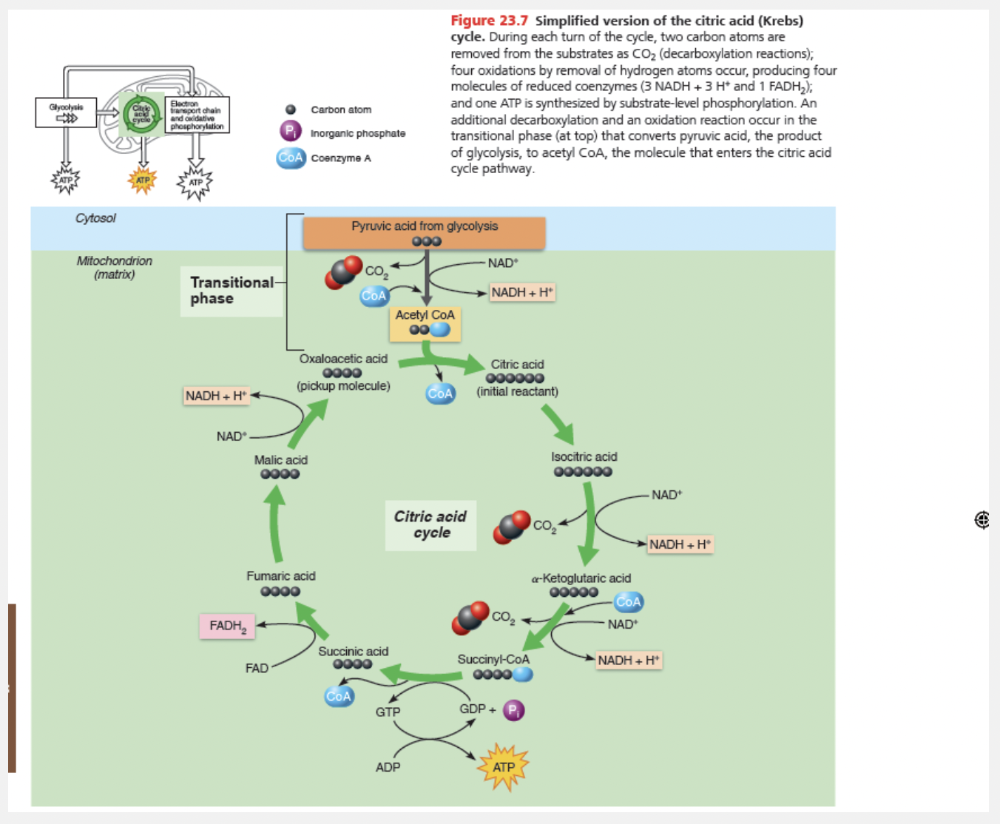
Fueled largely by pyruvic acid
Ex.
The citric acid cycle (or Krebs cycle) is fueled largely by pyruvic acid.
The citric acid cycle (or Krebs cycle) is the next stage of glucose oxidation and is named for its first substrate. The citric acid cycle occurs in the mitochondrial matrix and is fueled largely by pyruvic acid produced during glycolysis and by fatty acids resulting from fat breakdown. Because pyruvic acid is a charged molecule, it must enter the mitochondrion by active transport with the help of a transport protein. Once in the mitochondrion, the first order of business is a transitional phase that converts pyruvic acid to acetyl CoA.
This occurs via a three-step process:
- Decarboxylation. In this step, one of pyruvic acid’s carbons is removed and released as carbon dioxide gas, a process called decarboxylation. CO2 diffuses out of the cells into the blood to be expelled by the lungs. This is the first time that CO2 is released during cellular respiration.
- Oxidation. The remaining 2C fragment is oxidized to acetic acid by removing hydrogen atoms, which are picked up by NAD+.
- Formation of acetyl CoA. Acetic acid is combined with coenzyme A to produce the reactive final product, acetyl coenzyme A (acetyl CoA). Coenzyme A is a sulfur-containing coenzyme derived from vitamin B5.
Acetyl CoA is now ready to enter the citric acid cycle and be broken down completely by mitochondrial enzymes. Coenzyme A shuttles the 2-carbon acetic acid to an enzyme that joins it to a 4-carbon acid called oxaloacetic acid (ok″sah-lo″ah-sēt′ik) to produce the 6-carbon citric acid.
The final electron acceptor in the electron transport chain is __________.
- oxygen
- CO2
- water
- NADH
oxygen
Ex.
The final electron acceptor in the electron transport chain is oxygen.
Essentially all oxidation of food fuels involves the step-by-step removal of pairs of hydrogen atoms (with their electrons) from the substrate molecules, eventually leaving only carbon dioxide (CO2). Molecular oxygen (O2) is the final electron acceptor. It combines with the removed hydrogen atoms at the very end of the process, to form water (H2O).
The site of electron transport is the __________.
- cytoplasm
- golgi body
- mitochondrial outer membrane
- mitochondrial inner membrane (cristae)
- mitochondrial matrix

mitochondrial inner membrane (cristae)
Ex.
The site of electron transport is the mitochondrial inner membrane (cristae).
Energy-rich electrons picked up by coenzymes are transferred to the electron transport chain, built into the inner mitochondrial membrane. The electron transport chain carries out oxidative phosphorylation, which generates most of the ATP in cellular respiration.
Which of the following statements about "redox" reactions in human metabolism is correct?
- Coenzymes accept hydrogen.
- The substance being reduced loses an electron.
- Enzymes accept hydrogen.
- Oxidized substances gain energy.
Coenzymes accept hydrogen.
Ex.
It is correct that in redox reactions conezymes accept hydrogen.
Most of these enzymes require the help of a specific coenzyme, typically derived from one of the B vitamins. Although the enzymes catalyze the removal of hydrogen atoms to oxidize a substance, they cannot accept the hydrogen (hold on or bond to it). Their coenzymes, however, can act as hydrogen (or electron) acceptors, becoming reduced each time a substrate is oxidized.

The stage of metabolism indicated by “D” occurs in the _________.
- Mitochondrial matrix
- Mitochondrial outer membrane
- The major catabolic pathway
- Mitochondrial inner membrane
- Cytoplasm

Mitochondrial inner membrane
Ex.
The stage of metabolism indicated by `D` is oxidative phosphorylation, which occurs in the mitochondrial inner membrane.